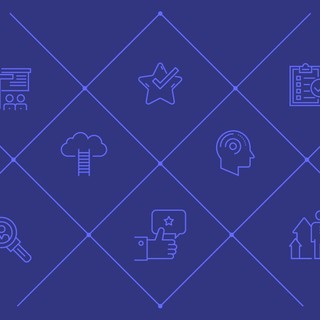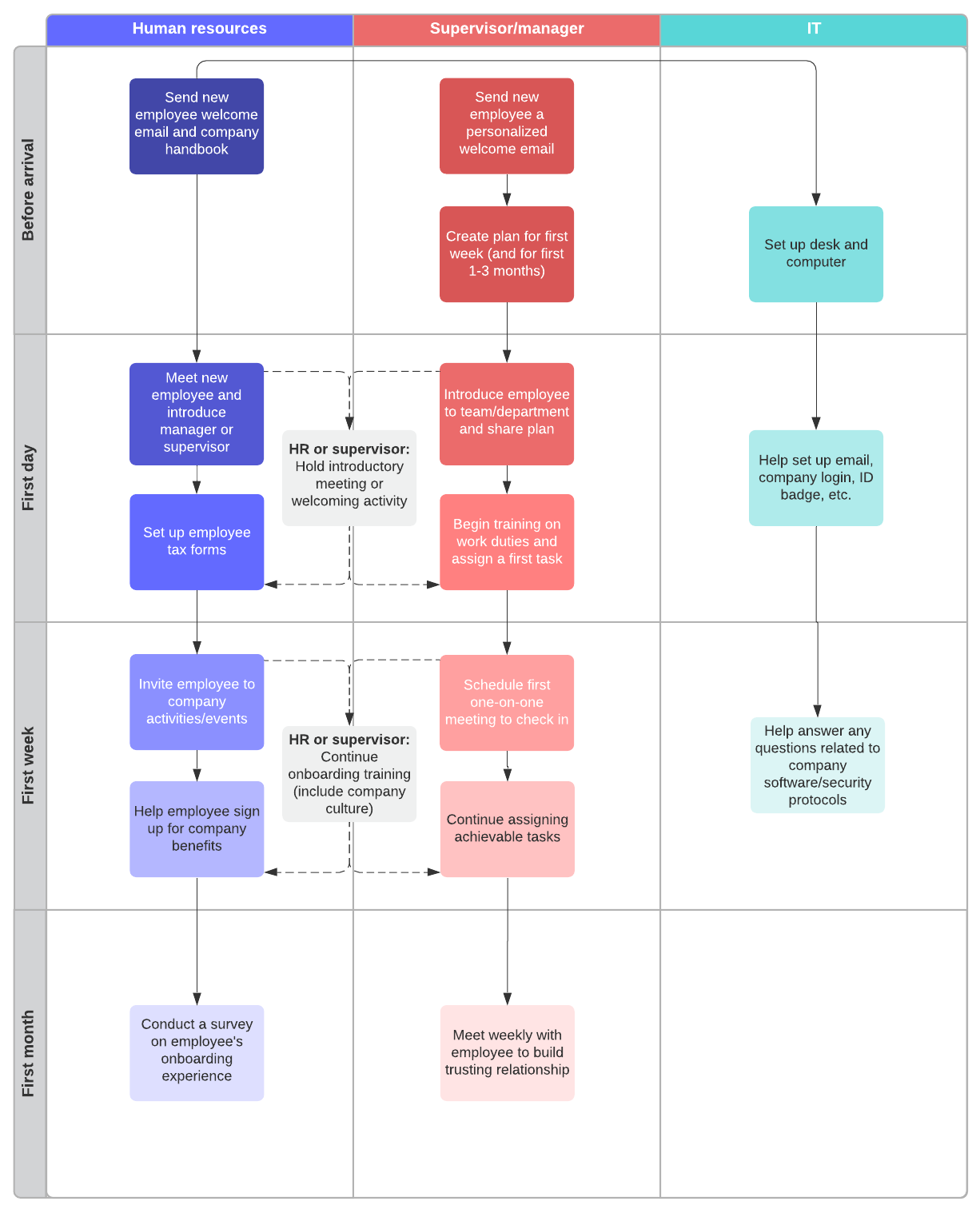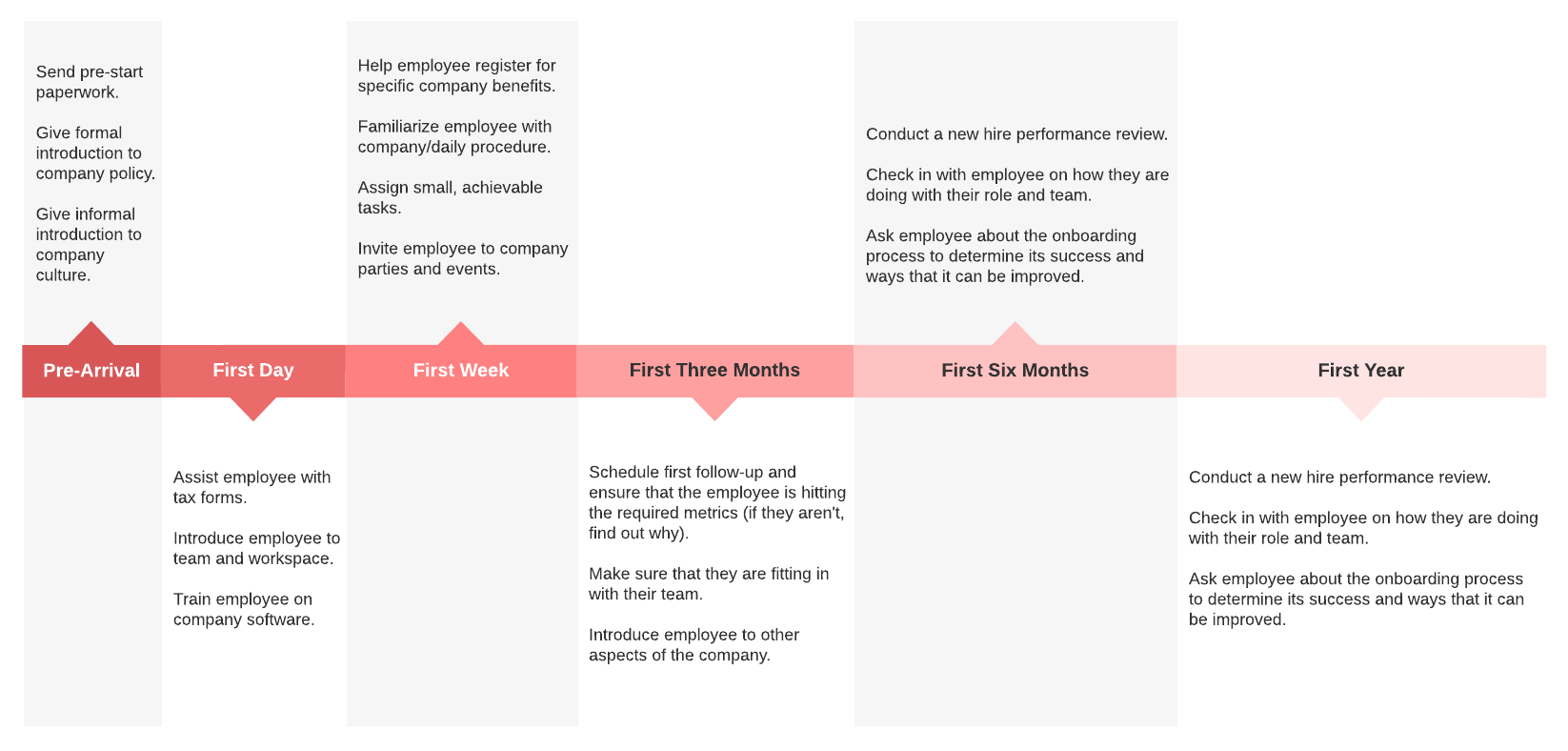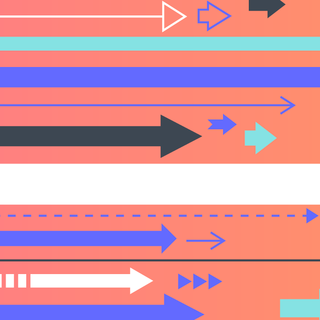What is onboarding?
Onboarding is the process of helping your company’s new hires adjust to the social and performance aspects of their jobs as quickly as possible.
Human Resources and training staff are highly involved in the beginning stages, with job function mentors and direct managers more involved in the later phases.
Did you know that 22% of companies have no formal onboarding process?
Building a strategic onboarding process for new hires improves employee retention beyond their first year and boosts employee performance. Creating an onboarding process flow not only properly introduces your new employees to the company culture, their responsibilities, and their co-workers but also helps new hires feel more welcome—which also helps your bottom line.
Randy Holley SHRM-SCP, a subject matter expert on HR management, describes best practices for onboarding new hires by:
"Telling employees the expectations, delivering impeccable training and support to meet those expectations and then create opportunities for easy but meaningful wins in the first few months."
Organizations with a standard onboarding process experience 50% greater new hire productivity and are 69% more likely to retain their employees up to three years. And with the cost of replacing an employee falling between 16% and 20% of that employee’s salary, holding on to those well-trained employees longer is better for you and your company.
What is the onboarding process?
An onboarding process is used to help new employees adjust to the social and performance aspects of their jobs as quickly as possible. Parts of the employee onboarding process can be as simple as introducing new hires to their coworkers and as complex as providing in-depth training on company software and procedures.
For a successful onboarding process consider the Four C’s of your organization:
- Compliance: Teaching new hires the basic rules, regulations, and policies that define your company.
- Clarification: Educating new hires on their job functions and performance expectations.
- Culture: Advising new hires on formal and informal organizational norms, such as the company dress code.
- Connection: Helping new hires to build interpersonal and interdepartmental relationships in your organization.
Benefits of using an onboarding process flow
Bringing new employees into an existing company structure can be difficult. That’s why we recommend building an onboarding process, with clearly defined roles for Human Resources, mentors, managers, and new hires.
When you document your onboarding process flow beforehand, your organization will be able to increase each new hire’s ability to contribute in their role quickly, increase their comfort level, and reinforce their decision to join your organization, leading to higher retention and better long-term performance for both the employee and the company.
Visualizing your onboarding process with a flowchart or a timeline will give new employees an easy-to-understand picture of their first year at your company, improve their ramp time, boost their performance, and lay out their feedback and review process.
There are two common approaches for building an onboarding process flow—by its five major stages and by its timeline. Read on below to learn about both in detail and see which is right for you and your organization.
Use the 5-stage process flow for onboarding
The first major approach divides the onboarding process into stages. Usually, Human Resources and training staff are highly involved in the beginning stages, with job function mentors and direct managers more involved in the later phases.
Preparation
Generally, the preparation stage of onboarding spans from the pre-arrival stage through about the first month or so of the new hire’s employment. This phase of the employee onboarding process includes pre-arrival paperwork, a formal introduction to the company’s policies and procedures, and an informal introduction to company culture through the employee’s environment.
Orientation
The orientation stage of the onboarding process usually takes place on the employee’s first day or week of work. This phase includes much of the Human Resources onboarding process:
- Filling out tax forms
- Introducing company values and culture
- Learning about and signing up for company benefits
- Introducing the employee to their workstation
- Reviewing safety, health, and other company policies
- Training the employee on specific software or procedural needs related to their job function
Integration
The integration phase of the new hire onboarding process doesn’t have a set time frame, but it generally goes on for the first six to 12 months of the employee’s journey with your organization. This phase has the employee slowly building up their work through mentorship from other employees with similar job functions.
Engagement
The engagement phase also lasts through the first year or so of the employee’s time on the job. This phase is all about personal relationships within the employee’s team, their manager and/or direct reports, and members of cross-functional teams. For example, our People Ops team at Lucid sets up “new hire lunches” so new employees have the chance to meet people from different teams. True engagement makes the new employee feel welcome and comfortable with the company culture.
Follow-up
The follow-up stage of the onboarding process for new employees is where you should evaluate the employee’s performance and integration into the team. Some companies do this at 90 days, some at six months, some at a year, some at all those milestones. Human Resources or the new hire’s manager meets with the employee to discuss if they are hitting specific performance metrics and also to evaluate how the employee “fits.” This employee onboarding phase also allows your organization to measure the efficacy of the onboarding program itself.

Learn actionable tips for enhancing your onboarding process with Lucidchart.
Find out moreCreate an onboarding process timeline
Another type of onboarding process flow uses a timeline, beginning before the employee’s start date—right after the employee is hired—and continuing through the first year of employment. The onboarding process flow includes tasks related to the new hire’s schedule and job duties, socialization, training, development, and work environment, performed by Human Resources, training staff, mentors, hiring managers, and the employees themselves.
The pre-arrival of a new employee
Once the employee is hired, confirm the start date with the new hire and begin preparation for their arrival. During this onboarding phase, it’s important to provide any information the employee needs for their first day, such as required identification or paperwork they can fill out ahead of time and the office’s dress code. Human Resources prepares for the employee’s arrival by getting paperwork for benefits and payroll ready, training staff readies for new hire orientation and job function training, and managers prepare for the employee’s first assignments. If necessary, get IT involved to set up the new hire’s workstation.
The employee’s first day
The next phase of the onboarding process begins on the employee’s first day. Greet them and bring them into the orientation room, where they’ll fill out any necessary paperwork. It’s important to get the employee set up at their workstation, instruct them on any programs they’ll need to communicate, let them know of their schedule for the first week, and invite them to any required meetings. Introduce the employee to their coworkers—a lunch gathering is the perfect place to do this in a relaxed, social setting. If applicable, give the employee their first assignment and get them working.
The employee’s first week
Throughout the employee’s first week, assist them in getting to meetings at the right time and place and give them small assignments that are achievable and measurable to get them up to speed. During new employee onboarding, mentors and/or managers should stick close to the employee to make sure they feel welcome and comfortable in their new role.
The employee’s first month
Throughout the first month of onboarding, continue to work with the employee to integrate, giving them larger and larger assignments and introducing them to more co-workers across the company. Schedule regular one-on-one meetings to evaluate their performance and make sure they feel comfortable. Human resources should check in to make sure payroll and benefits are properly activated.
The employee’s first 90 days
At the 90-day marker, it’s a good idea to check in and review the employee’s performance and to gauge their feelings about their work environment. Continue to introduce the employee to the company’s different aspects, even outside of their job function, and involve them in corporate social events, both formal and informal, to expose them to more of the company culture.
The employee’s first six months
Managers and/or mentors should collaborate with the new hire on a six-month performance review to evaluate not only the employee’s job function but also the success of the onboarding process for new employees. At this point, the employee should be fully integrated into the team’s workflow and the company culture.
The employee’s first year
Parts of the onboarding process throughout the rest of the first year build upon the foundation of what has come before. As the employee gets more acclimated, they should be encouraged to participate more in company committees and cross-functional teams and to contribute to the company culture. The end of an employee’s first year is a perfect time for performance evaluation—and if you see your employee performing well both individually and as a member of the larger team, you will know that your onboarding process has been a success.
Create an onboarding process workflow with Lucidchart
Whichever method you choose to build your onboarding process flow—by phase, timeline, or a combination of the two—you can use Lucidchart to visualize and illustrate the onboarding process to improve your employee's experience, boost performance, and increase retention. Even add swimlanes to delineate the responsibilities involved through your onboarding process.


No matter how many people are involved in your onboarding process, you can diagram each person’s role, responsibilities, and accountabilities easily and clearly. Because Lucidchart exists in the cloud, it’s simple to share an always up-to-date onboarding process right in Lucidchart or store it through one of our many integrations.

Find out how to document and analyze your onboarding process to improve the new hire experience.
Learn howAbout Lucidchart
Lucidchart, a cloud-based intelligent diagramming application, is a core component of Lucid Software's Visual Collaboration Suite. This intuitive, cloud-based solution empowers teams to collaborate in real-time to build flowcharts, mockups, UML diagrams, customer journey maps, and more. Lucidchart propels teams forward to build the future faster. Lucid is proud to serve top businesses around the world, including customers such as Google, GE, and NBC Universal, and 99% of the Fortune 500. Lucid partners with industry leaders, including Google, Atlassian, and Microsoft. Since its founding, Lucid has received numerous awards for its products, business, and workplace culture. For more information, visit lucidchart.com.
